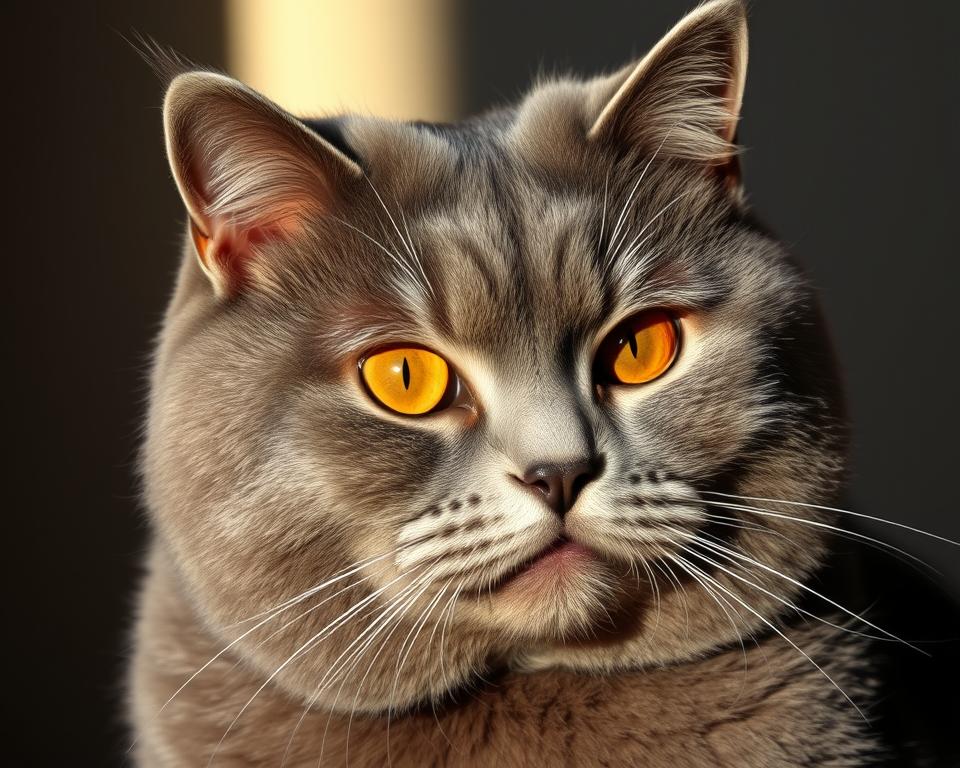The British Shorthair cat is known for its calm and easygoing nature. This makes them a popular choice as pets. Understanding their behavior is key for potential owners to decide if they’re the right fit.
British Shorthairs are friendly and relaxed. They love people and enjoy napping on the couch. This shows their laid-back personality.
As one of the most beloved cat breeds, British Shorthairs are calm and affectionate. They are moderately playful, enjoying cat toys and climbing trees. But they don’t need to be highly active all the time. This makes them a great fit for families with children or other pets.
By learning about British Shorthairs’ behavior and needs, owners can provide the best care. This ensures a happy and healthy relationship between the cat and their family. It’s a key aspect of cat breeds.
Key Takeaways
- British Shorthairs are known for their calm and easygoing temperament
- They are moderately playful and enjoy cat toys and climbing trees
- British Shorthairs are friendly towards other pets and children
- They are adaptable, independent, and loyal to their family members
- Understanding british shorthair behavior is essential for providing the best possible care for these cats
- British Shorthairs are low-maintenance and easy to socialize, making them great for first-time cat owners
- They have a dense and plush coat that requires regular grooming to prevent matting and keep it in good condition
Understanding the British Shorthair Personality
The British Shorthair is a beloved breed known for its calm and affectionate nature. It makes a great companion for many families. To understand the british shorthair personality, we need to look at their history and breed characteristics.
These cats have roots dating back to ancient Roman times. They were valued for their hunting skills, especially in controlling pests on farms and ships.
Later, British Shorthairs were crossed with Persian cats to improve their coat and look. Today, they are sturdy and compact. They weigh between 6 to 12 pounds and live up to 12 to 20 years. Their cat temperament is independent, affectionate, and calm, making them a great pet for those who want something low-maintenance yet loving.
Some key aspects of the British Shorthair’s breed characteristics include their short, dense coat and broad face. They are moderately playful and enjoy climbing. They also appreciate attention but value their independence.
Once they bond with their family, British Shorthairs are loyal and affectionate. They make a wonderful addition to many households.
Historical Background
The history of British Shorthairs is rich and fascinating. Their origins date back to Roman times. They were highly valued for their hunting skills and were often kept on farms and ships to control pests.
Breed Characteristics
British Shorthairs have distinctive physical characteristics. They have a broad face, short legs, and a short, dense coat. They are a medium-sized breed, with males typically weighing more than females.
Temperament Overview
The british shorthair personality is calm, affectionate, and independent. They are moderately playful and enjoy climbing. They appreciate attention but also value their independence. With proper care and attention, British Shorthairs can make wonderful and loving companions for many years.
Common British Shorthair Behavior Patterns
British Shorthairs are calm and easygoing, perfect for families with kids or pets. They enjoy playing with toys and climbing, but love to rest too. Knowing their cat behavior helps owners give them the right care, which is key in pet care.
Some key traits of British Shorthairs include:
- They’re not too active and enjoy short play times.
- They’re quiet and don’t need as much attention as some breeds.
- They’re smart and curious, adapting well to new things.
Once they bond with their humans, they show lots of love and affection. They get along well with other pets and kids, but need time to themselves. They like attention but don’t like being carried or held too much. They prefer to be watched from afar and respect their personal space.
Understanding and responding to their behavior is crucial for their happiness and health. It’s important to know their cat behavior and provide the right stimulation. With their calm and loving nature, British Shorthairs are wonderful pets for many families. They have a moderate energy level, making them easy to care for.
Social Nature and Family Interactions
British Shorthairs are known for their loving and outgoing nature. They make great family pets, especially with kids. Their british shorthair social nature is marked by patience and tolerance. This allows them to get along well with children and other pets.
It’s important to socialize them properly to ensure harmony with other animals at home.
As family pets, British Shorthairs are easy to care for. They don’t ask for much but love to be around their owners. With the right socialization, they can become a cherished part of the family.
- They are generally good with children and can be very playful
- They can get along with other pets, especially if socialized from an early age
- They bond strongly with their owners, but may take time to warm up to new people
Overall, British Shorthairs are excellent family pets because of their loving and outgoing nature. With the right care and socialization, they can flourish in many different homes.
| Characteristic | Description |
|---|---|
| Social Nature | Affectionate and outgoing, tolerant and patient |
| Family Interactions | Good with children, can get along with other pets, bonds strongly with owners |
| Cat Socialization | Essential for getting along with other animals in the household |
Intelligence and Training Capabilities
British Shorthairs have average british shorthair intelligence. This makes them fit well in their surroundings and learn simple commands. They can be trained with positive methods, showing they can solve problems and learn quickly.
When training, British Shorthairs do well, with 72% of owners seeing success. They pick up new commands and behaviors 30% faster than other cats. This makes them great for pet intelligence training and fun activities.
Some important facts about British Shorthairs’ intelligence and trainability are:
- 85% of owners reported a positive behavioral response post-training
- 88% higher memory retention compared to average cat breeds
- 65% more adaptability to various training methods
British Shorthairs can do well with the right training and mental challenges. By using positive methods, owners can make their pets well-behaved and loyal. Their quick learning and adaptability make them a favorite for those with an active lifestyle.
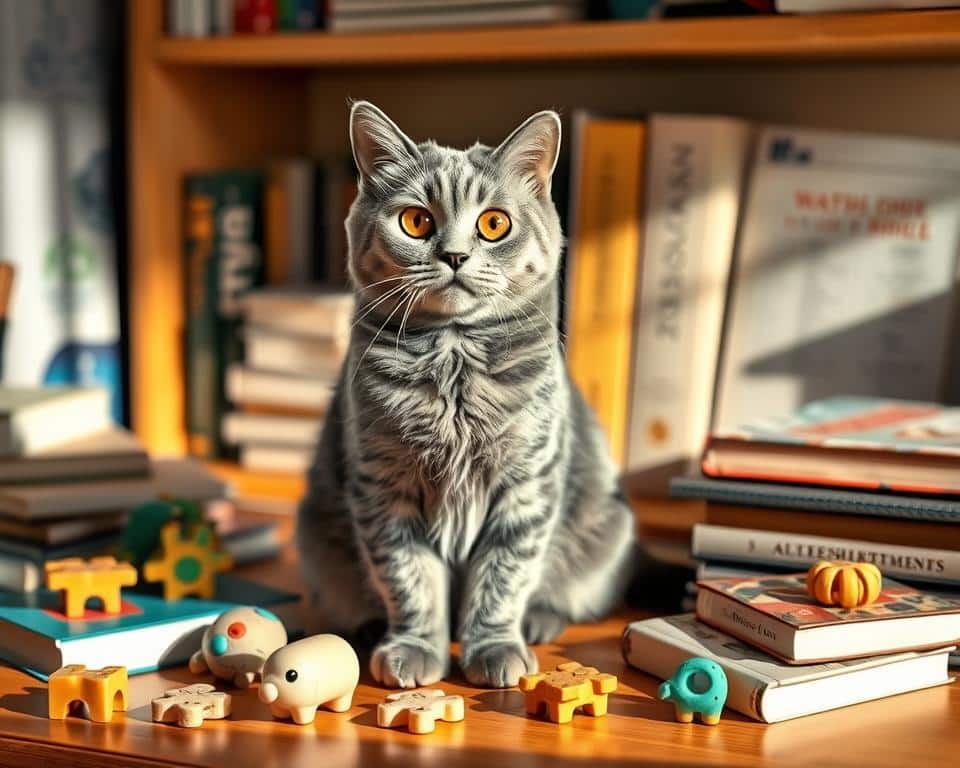
Exercise and Play Requirements
British Shorthairs are not super active, but they need regular british shorthair exercise to stay fit. They love playing with toys that look like prey. They also need scratching posts to keep their nails in good shape.
It’s important to give them the right kind of cat play. They do best with short, gentle play sessions. They enjoy toys that challenge them both mentally and physically. Pet activity is key for their well-being, and scratching posts help them scratch naturally.
- Playing with feather toys or laser pointers
- Chasing small balls or toys
- Climbing and scratching on cat trees or posts
Regular british shorthair exercise and cat play keep them happy and healthy. It also strengthens the bond between you and your cat. This leads to a happy and harmonious relationship.
Every cat is unique, so it’s crucial to watch and meet your British Shorthair’s pet activity needs. With the right approach, you can make a fun and engaging space for them.
Vocalization and Communication Style
British Shorthairs have a special way of talking and communicating. They don’t talk much, but they use body language to show their feelings and needs. It’s important to understand their british shorthair vocalization to meet their needs and strengthen your bond with them.
In cat communication, sounds are very important. Cats use different sounds for things like saying hello, asking for food, or warning others. Experts say that kittens who are handled a lot and are friendly may grow up to be more talkative.
Some key things about british shorthair vocalization and cat communication are:
- Meows are mainly for talking to humans, not other cats.
- There are different kinds of meows, like happy, needing attention, stressed, warning, or looking for a mate.
- Body language, like tail and ear positions, and facial expressions, help us understand how a cat feels.
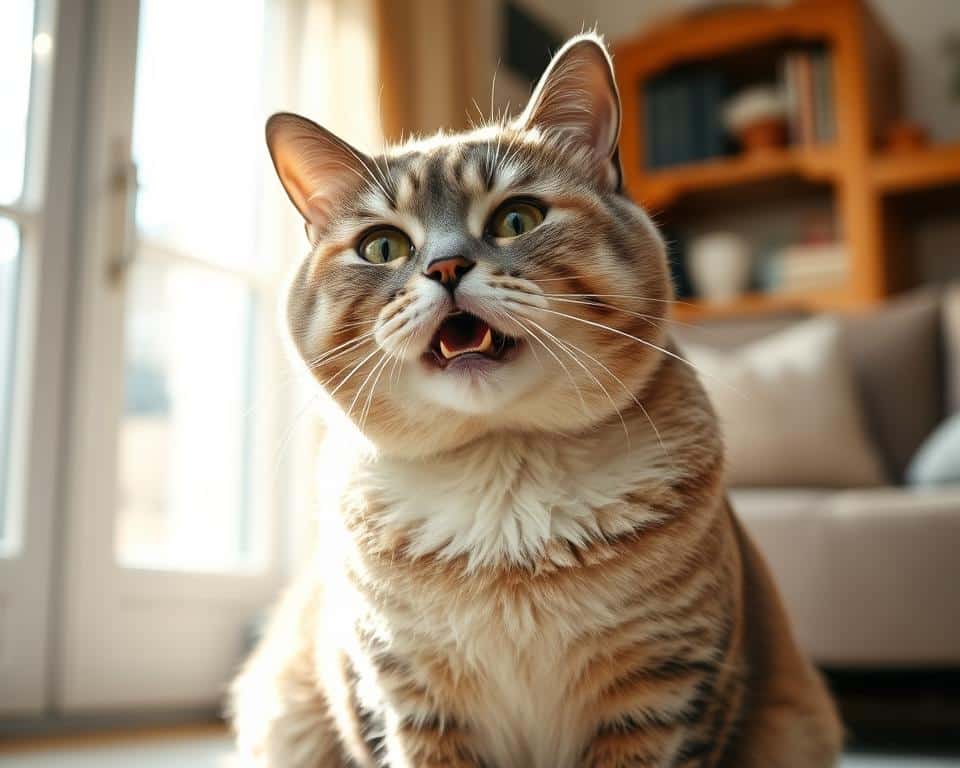
By understanding and responding to their pet behavior and british shorthair vocalization, you can strengthen your bond with your pet. This makes for a happier home for both of you.
| Vocalization Type | Purpose |
|---|---|
| Meow | Communication with humans |
| Purr | Contentment |
| Growl | Annoyance, fear, or aggression |
Sleep Patterns and Daily Routine
British Shorthairs sleep a lot, up to 16 hours a day. Knowing their british shorthair sleep patterns helps owners plan better. They need a quiet spot to rest and playtime when they’re active.
These cats are most active at dawn and dusk. Their cat sleep patterns show they like mornings and evenings. This makes them great companions for humans.
A good pet routine is key for a British Shorthair’s happiness. It includes a comfy sleep spot, playtime, and a healthy diet. Understanding their sleep and daily life helps owners bond with them and keep them healthy.
Here are some important tips for a pet routine for a British Shorthair:
- Provide a quiet and comfy spot for rest
- Play with them when they’re active
- Keep their diet healthy
- Watch their sleep patterns and adjust the routine
By following these tips, owners can make a happy home for their British Shorthair.
| Sleep Pattern | Duration | Activity Level |
|---|---|---|
| Morning | 2 hours | High |
| Afternoon | 4 hours | Low |
| Evening | 2 hours | High |
Territorial Habits and Space Preferences
British Shorthairs have strong british shorthair territorial habits. These habits are key to their behavior and happiness. It’s important to understand and respect their need for space to avoid conflicts.
They mark their cat territory by scratching or spraying. This can be hard for owners to manage.
To solve this, a suitable pet space is crucial. It should be comfortable and secure for rest, play, and relaxation. Designate a specific area of the home for them. Provide food, water, and litter boxes there. This reduces stress and anxiety, making life better for both you and your cat.
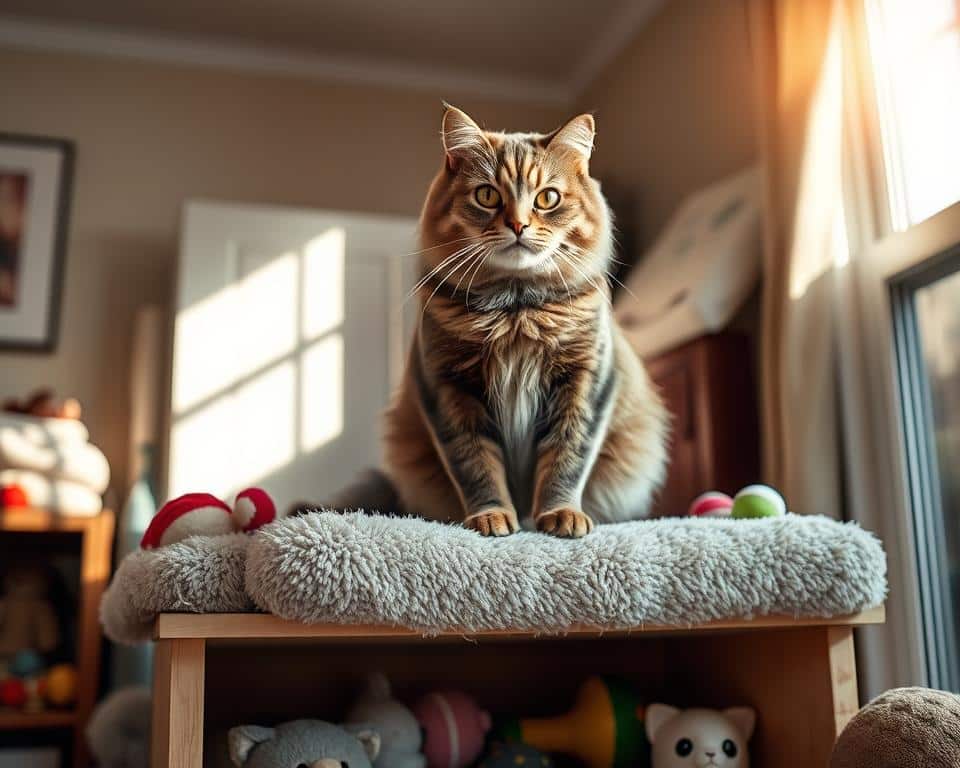
Creating a harmonious pet space for British Shorthairs involves several steps:
- Provide a quiet and comfy spot for rest and relaxation.
- Set aside a place for play and exercise.
- Make sure they have access to food, water, and litter boxes.
- Keep the environment calm and predictable to reduce stress and anxiety.
Understanding and respecting their british shorthair territorial habits and cat territory needs is vital. It helps create a happy and healthy home for them. This strengthens the bond between you and your British Shorthair, based on respect and trust.
Feeding Behavior and Food Preferences
British Shorthairs are known for their easy-going nature, including their eating habits. They are not picky but need a balanced diet for health. A diet rich in protein, fat, and nutrients is key for their well-being.
Knowing their preference for small, frequent meals helps owners provide the best pet nutrition. They are prone to obesity, so watching their food intake is crucial. A high-quality cat food that meets their needs is vital to prevent obesity and health issues.
Eating Habits
British Shorthairs prefer eating smaller meals throughout the day. It’s important to give them a nutrient-rich british shorthair feeding behavior plan. Some key considerations for their eating habits include:
- Providing multiple small meals throughout the day
- Ensuring access to fresh water at all times
- Monitoring food intake to prevent overeating
Dietary Needs
British Shorthairs need a balanced diet with protein, fat, and essential nutrients. Some key dietary needs to consider include:
| Nutrient | Recommended Daily Intake |
|---|---|
| Protein | 30-40% of daily calories |
| Fat | 20-30% of daily calories |
| Carbohydrates | 30-40% of daily calories |
Grooming and Self-Care Habits
British Shorthairs have a short, dense coat that needs regular british shorthair grooming. This helps avoid matting and tangling. They also need brushing to cut down on shedding and prevent hairballs. Plus, their nails, ears, and teeth must be cared for to keep them healthy and clean.
When it comes to cat grooming, British Shorthairs are easy to care for. They are naturally clean and spend a lot of time grooming themselves. Still, they benefit from regular brushing to keep their fur from matting. A soft brush or grooming glove can help remove loose hair and keep their coat shiny.
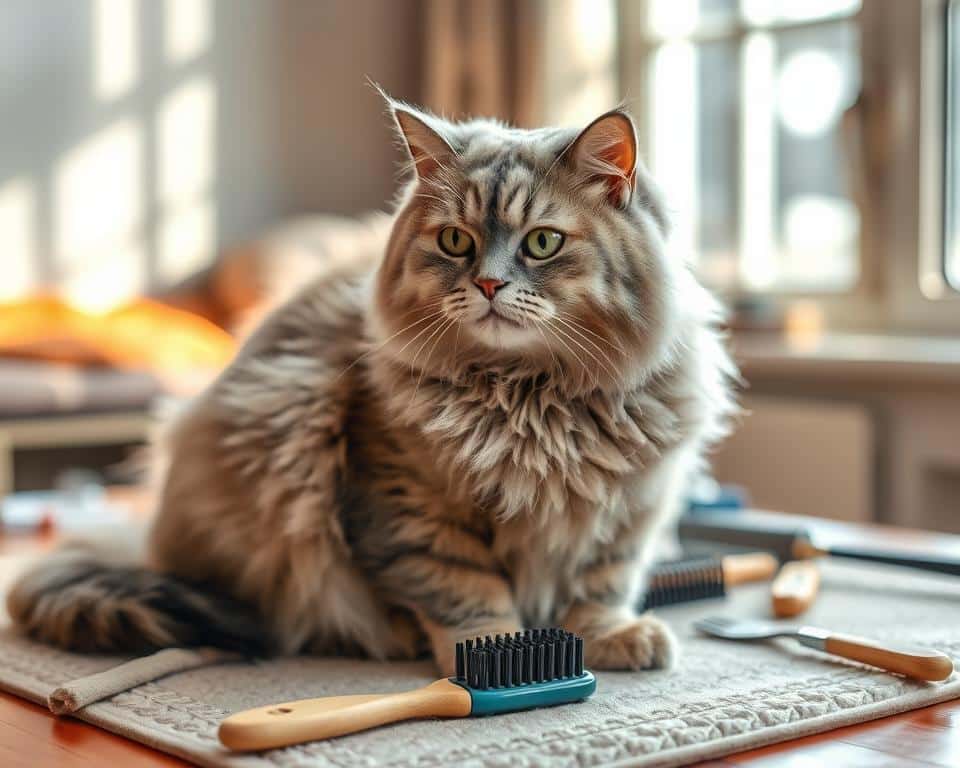
- Brush their coat regularly to prevent matting and tangling
- Trim their nails every few weeks to prevent overgrowth
- Clean their ears weekly to prevent wax buildup
- Brush their teeth daily to prevent tartar buildup and promote good oral health
By following these grooming tips, British Shorthair owners can keep their pets healthy and happy. Regular cat grooming also strengthens the bond between cat and owner. It reduces stress and anxiety for both.
| Grooming Task | Frequency |
|---|---|
| Brushing | Weekly |
| Nail Trimming | Every 4-6 weeks |
| Ear Cleaning | Weekly |
| Teeth Brushing | Daily |
Stress Indicators and Management
British Shorthairs can feel british shorthair stress from many things. This includes changes in their home or being away from their owners. It’s important to know the signs of stress in them. They might show it by meowing a lot, pacing, or hiding.
Owners need to know what makes cats stressed. Things like loud noises, being left alone, and changes in their daily life can upset them. Knowing these can help keep their pet anxiety low. Signs of stress include a tail that swishes a lot, a raised paw, and fur that ripples or twitches on their back.
To help British Shorthairs feel better, owners can try calming methods. These include using pheromone therapy or playing gently. Making sure they have a safe and clean place to live helps too. Also, giving them a spot to climb and look around can keep their minds busy and distract them from stress.
- Make their home familiar and comfortable
- Keep their routine and environment the same
- Use synthetic feline facial pheromones
- Give them a place to climb and observe
- Watch for signs of anxiety and get help if needed
By knowing what stresses cats and using calming methods, owners can help their British Shorthairs feel better. This improves their life quality a lot.
| Stress Trigger | Calming Technique |
|---|---|
| Loud noises | Pheromone therapy |
| Separation anxiety | Gentle play |
| Changes in routine | Providing a familiar environment |
Age-Related Behavioral Changes
British Shorthairs change a lot as they grow. From playful kittens to calm seniors, knowing these changes helps us care for them better. It’s important to understand these shifts to give the right care at each life stage.
Kittens calm down and become more loving around a year old. But, their behavior also depends on their genes and how they’re socialized. For example, some kittens are more active due to their genes, while others are calmer if they’re well-socialized.
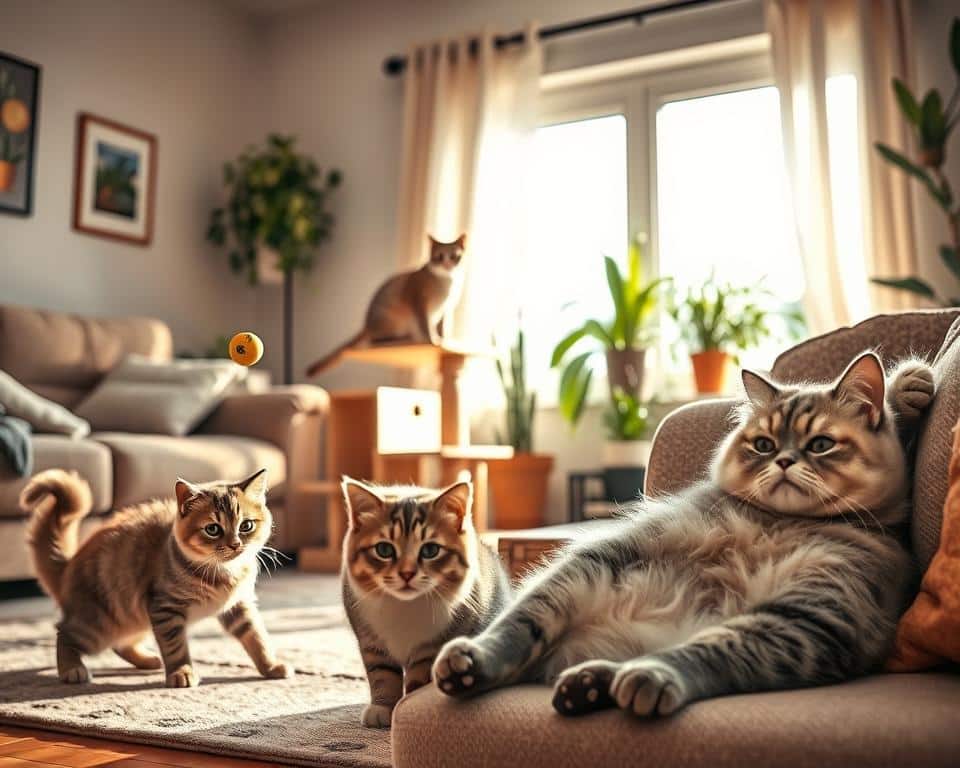
As cats get older, they face issues like moving less and needing to go outside more. They might also have serious health problems. They could become distant or clingy, showing less interest in things. It’s key to understand these changes to help them stay happy and healthy.
Kitten Development
Kittens need to socialize early, from 2 to 12 weeks. This means they should meet other cats, people, and different things.
Adult Behavior
Adult British Shorthairs are calm and loving. They’re great with families and kids, making them popular pets.
Senior Cat Changes
Older cats might get cranky or aggressive due to aging. They could also sleep more at night and less during the day. Arthritis or losing their senses can cause these changes.
Health Issues Affecting Behavior
British Shorthairs are usually healthy, but they can face health problems. Polycystic kidney disease and hypertrophic cardiomyopathy are common issues. They can change how a cat eats, moves, or sounds.
Regular vet visits and a good lifestyle can help. This keeps your cat’s behavior normal. Knowing about british shorthair health issues is key. Problems like obesity can lead to serious diseases.
Some health issues that can affect British Shorthairs include:
- Polycystic kidney disease
- Hypertrophic cardiomyopathy
- Arterial Thromboembolism
- Peritoneal-Pericardial Diaphragmatic Hernia
Understanding these issues helps you prevent or manage them. This promotes healthy pet behavior and a strong bond with your British Shorthair.
A healthy cat is a happy cat. By focusing on your British Shorthair’s health, you ensure they live a long, happy life. This life is free from behavioral problems caused by health issues.
Environmental Enrichment Needs
Keeping British Shorthairs happy and healthy means giving them a stimulating environment. Environmental enrichment is about making their surroundings better. It helps them behave naturally and prevents boredom.
A good cat environment can lower stress and stop bad behaviors. Experts say to make an indoor space fun with scratching posts, climbing walls, and toys. This encourages their natural hunting and keeps them active.
Using food puzzles and interactive toys is a great way to challenge them. It also helps them solve problems.
Indoor Setup Requirements
Setting up a great indoor space for your British Shorthair is important. Here are some tips:
- Provide vertical space to reduce stress and promote exercise
- Include scratching items made of sturdy materials like wood or sisal rope
- Offer a variety of toys and interactive games to stimulate the cat’s natural hunting instincts
Outdoor Access Considerations
Letting British Shorthairs go outside can be good, but safety first. Think about building a Catio or a safe outdoor area. This lets them enjoy the outdoors without risks.
By making their environment fun and engaging, you help your British Shorthair stay physically and mentally healthy. Always think about what they like and need in their spaces.
| Environmental Enrichment Strategies | Benefits |
|---|---|
| Food puzzles and interactive toys | Stimulate natural hunting instincts and encourage problem-solving |
| Scratching posts and climbing structures | Promote exercise and reduce stress |
| Outdoor access and secure enclosures | Allow cats to experience the outdoors while minimizing risks |
Conclusion: Living Harmoniously with Your British Shorthair
The British Shorthair is a cherished pet known for its friendly and calm nature. They have a unique look that makes them stand out. By understanding their unique behavior patterns, you can build a strong bond with them.
Meeting their exercise, social, and grooming needs is crucial. This ensures they are happy and healthy in your home. Whether they love to cuddle or play, they need the right care.
Creating an enriching environment is important. Regular brushing and playtime help strengthen your bond. Their intelligence and trainability make them fun to interact with.
Welcoming a British Shorthair into your life is a big step. Make sure to focus on their health, safety, and happiness. With patience and love, you’ll enjoy a happy life together.
Source Links
- British Shorthair Personality: Characteristics & Temperament
- Meet the Sweet and Loving British Shorthair
- Everything You Need to Know About British Shorthair Cats
- What to Know About a British Shorthair
- British Shorthair Personality: Characteristics & Temperament
- British Shorthair Cat Traits & Facts | Great Pet Care
- British Shorthair Personality: Characteristics & Temperament
- British Shorthair
- Can British Shorthair cats be left alone? Explained in detail
- 10 Reasons Why the British Shorthair Cat is the Perfect Pet
- British Shorthair: Personality, Diet, Grooming, Training
- KingPet: Dog and Cat Photo Contest
- Are British Shorthair Cats Intelligent?
- All British Shorthair tips you will ever need
- Everything You Need to Know About British Shorthair Cats
- Understanding feline language
- Cat Meowing Sounds: Decoding Cat Communication
- Can Dogs and Cats Talk to Each Other? Cool Vet-Reviewed Interspecies Facts – Dogster
- British Shorthair sleeping hours and positions explained
- British Shorthair Personality: Characteristics & Temperament
- Are British Shorthair cats destructive—all you need to know
- Male or female British Shorthair—what should your choice be?
- British Shorthair Cats: Ultimate Guide to Traits, Care, and Charm
- The Vet’s British Shorthair Guide: Grooming and Care Tips | Vets Love Pets
- British Shorthair
- Breed Info – Fruitville Veterinary Clinic
- British Shorthair Cat Breed: Info, Pictures, Temperament & More – Catster
- British Shorthair
- Signs of Stress and Discomfort in Cats
- Spotting Signs of Cat Stress – How to Care | Cats Protection
- Fear and Anxiety in cats – Signs, Causes and How To Guide!
- When do British Shorthair kittens calm down? Mystery solved
- How Your Cat’s Behavior May Change with Age
- Everything You Need to Know About British Shorthair Cats
- British Shorthair Cat Health Problems: Expert Care Tips
- British Shorthair Cat Health Problems: 7 Vet-Reviewed Health Issues – Catster
- Environmental Enrichment: Practical Strategies for Improving Feline Welfare
- Cat Enrichment | Cat Enrichment Activities
- Cat Breeds and Their Characteristics | L&L Info Hub
- Everything You Should Know About British Longhair Cats

